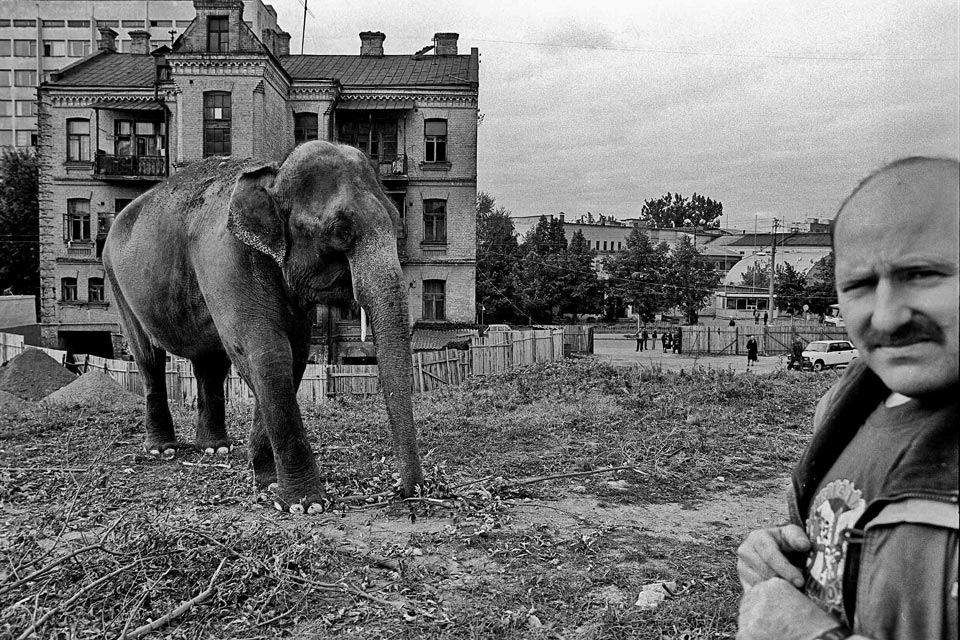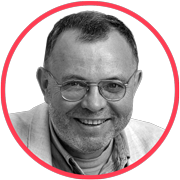
Valeriy Miloserdov’s 10 Favorite Photos

There are places in Kiev where I always get great photos, and one of them is Glory Park. In November, 1993, on the anniversary of the liberation of Kiev, I went to shoot the laying of wreaths at the Tomb of the Unknown Soldier along with about twenty other photojournalists and cameramen. There was some liveliness in the distance, as a column of high-ranking officials was moving towards us, and suddenly there was a loud clanging of metal against stone. I quickly turned the camera towards the sound and pushed the button for the shot: one of the soldiers of the honor guard was lying unconscious on the granite walkway. I managed to get just one shot – the boy was instantly carried off. One of the photographers standing nearby just asked what had happened.
{“img”: “/wp-content/uploads/2015/05/Miloserdov_01.jpg”, “alt”: “Valeriy Miloserdov”}
Cartagena, Colombia, fall of 1995. I was shooting the summit of non-aligned (to military blocs – Ed.) countries in a grand meeting hall. The heads of more than a hundred states were there. Suddenly I heard some movement behind me, turned around and saw Fidel Castro walking directly towards me. I saw him the night before during an official group photo shoot. Out of all the heads of state, only he took a few steps towards the press platform, raised his hand in greeting and cheerfully shouted in Spanish, “Hello, photographers!” The greeting was drowned out in the roar of the shutters. Now, Fidel was trying to be inconspicuous as he walked seemingly mired in grim thoughts. I stepped to the side and took one shot of him.
{“img”: “/wp-content/uploads/2015/05/Miloserdov_02.jpg”, “alt”: “Valeriy Miloserdov”}
August 20th, 1991, Moscow, in the midst of the GKChP putsch. That evening, I was working in Izvestia’s dark photo lab on the day’s material. Ahead was the night vigil outside of the Russian Parliament. One of the heads of the editorial staff burst into the laboratory and yelled, “Something’s going down near the editor’s windows, the protesters on Tverskaya stopped the armored vehicles!” There was no time to go down, so I took the shot from an open window on the fifth floor. Darkness. An old Nikon F, 200mm telephoto, hand exposure to 1/30. There were people holding hands on the street and standing in front of a column of putschist infantry fighting vehicles. The head vehicle couldn’t withstand the confrontation and started turning around. Jubilant youths clung to the vehicle and raised the Russian flag. The ICVs started leaving.
Recently I was showing this photo to a young photographer from Moscow. He couldn’t believe that this happened in his city. To this day it doesn’t even seem to me like the key moment in the fall of the USSR, but more like a dream sequence.
{“img”: “/wp-content/uploads/2015/05/Miloserdov_03.jpg”, “alt”: “Valeriy Miloserdov”}
This shot was taken in July of 1995 at Partizanskaya mine in the city of Antratsit, Lugansk oblast, during work on my “Disposable People” series (1994–1999) about the lives of miners in Donbass. I had developed a trusting relationship with the mining regions by that time and, even though I was only shooting there on short visits, there was a feeling each time that I was meeting new, yet familiar, well-known people.
I needed shots of my characters without their outer shells in order to complete the story. They became pristine people again, having washed off the dirt they accumulated. This opportunity appeared in Antratsit. A team of miners allowed me to photograph them while they were in the shower. I wasn’t particularly bothered with the subject matter and filmed everything that popped into the frame. It was a light and fun atmosphere. When I started looking at the material after the shoot, this frame immediately drew my attention. The man closed his eyes with his hands and turned into some sort of mythical creature, some mixture of conscious human and primitive animal. It was just a moment but the feeling was there. For me, this picture became a kind of meaning of all that was happening in Donbass. Later on, this photo was chosen for the poster of my exhibition, Vostok, at the Images’00 festival in Switzerland.
{“img”: “/wp-content/uploads/2015/05/Miloserdov_04.jpg”, “alt”: “Valeriy Miloserdov”}
I was once told that the arriving circus troupe walks their elephant once a day near the circus in Kiev. At first I didn’t believe it but I decided to go and have a look. It turned out that miracles can happen. The elephant was hovering peacefully in a vacant lot. It was fall, 1998. Now, there is a house on this space, and the place in Kiev where elephants once walked is dead.
{“img”: “/wp-content/uploads/2015/05/Miloserdov_05.jpg”, “alt”: “Valeriy Miloserdov”}
Minsk, December, 2000, meeting of the heads of state of the CIS. I spent the whole day at the airport taking pictures of the arrivals of all the presidents of the Commonwealth. There was an impenetrable fog, and the weather reflected the shady and ineffective meeting that took place and the very existence of the meaningless Commonwealth of Independent States. However, that day it was enough to experiment with shooting in fog, artificial lighting and new black-and-white film.
{“img”: “/wp-content/uploads/2015/05/Miloserdov_06.jpg”, “alt”: “Valeriy Miloserdov”}
This is a snapshot from last year’s series, “Entrance to the Tunnel.” I’m interested in the exact moment when the train crosses the border between the subway platform and the tunnel. First, it’s very photogenic (just try to catch it!), and second, it has something in common with our present state of affairs. In this one the train is entering the tunnel at the Kiev metro station Petrovka.
{“img”: “/wp-content/uploads/2015/05/Miloserdov_07.jpg”, “alt”: “Valeriy Miloserdov”}
On a dank night in Geneva in January, 1997, we drank iced vodka at the house of the beautiful Swiss actor Dominique Noble (now, unfortunately, deceased) and talked about photography. I asked him what he thought about why there aren’t any people in Swiss photographers’ shots. Dominique said that he had never thought about it. He stayed quiet for a minute and then answered, “We’re used to the idea that everything has a bar code, we know the value of each object and that’s how we appreciate them. Man does not have a bar code, we do not know his price and for us it’s something incomprehensible. Strange things are impossible to assess.” It was hard to disagree with him.
When I notice now that people are gradually beginning to disappear from my photos, I think, surely I look for and yet can’t find these human bar codes? This shot was taken in winter at the Kiev Podol in the industrial zone. Interesting that it’s such a deserted place.
{“img”: “/wp-content/uploads/2015/05/Miloserdov_08.jpg”, “alt”: “Valeriy Miloserdov”}
This is another recently discovered, funny place in Kiev for shooting, on Lysenko Street in the center. There is a small food shop with a sign that exudes some kind of psychedelic light at night behind the Opera and Ballet Theater. The passing cars add their color and the ordinary street setting completes the color picture. Whichever people fall into the shot doesn’t have any special significance, in my opinion.
{“img”: “/wp-content/uploads/2015/05/Miloserdov_09.jpg”, “alt”: “Valeriy Miloserdov”}
This shot was taken in the beginning of April of this year in Kramatorsk, the temporary capital of Donetsk oblast. For me, it reflects the current state of Donbass. It’s good that, two weeks after this shot was taken, the citizens of Kramatorsk demolished the Lenin statue.
{“img”: “/wp-content/uploads/2015/05/Miloserdov_10.jpg”, “alt”: “Valeriy Miloserdov”}
New and best




